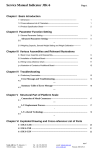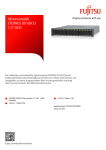Download Fujitsu Siemens Computers X103 SFF User's Manual
Transcript
Professional PC Operating Manual Edition X103 SFF English Are there ... ... any technical problems or other questions which you would like to be clarified? Please contact: ● our Hotline/Help Desk (see the included Help Desk list or go to: www.fujitsu-siemens.com/support/helpdesk.html) ● your sales partner ● your sales outlet Further information can be found in the "Safety" and "Warranty" manuals. The latest information on our products, tips, updates, etc., can be found on the internet under: www.fujitsu-siemens.com This manual was produced by cognitas. Gesellschaft für Technik-Dokumentation mbH – www.cognitas.de Published by Fujitsu Siemens Computers GmbH AG 08/05 Edition 1 Order No.: VFY-SCED103S Introduction Important notes Edition X103 SFF Preparation for use and operation Troubleshooting and tips System expansions Operating Manual Technical data Index August 2005 edition Microsoft, MS, MS-DOS, Windows, and Windows NT are registered trademarks of Microsoft Corporation. VESA and DPMS are trademarks of Video Electronics Standards Association. PS/2 is a registered trademark of International Business Machines, Inc. Pentium is a registered trademark of Intel Corporation, USA. All other trademarks referenced are trademarks or registered trademarks of their respective owners, whose protected rights are acknowledged. Copyright © Fujitsu Siemens Computers GmbH 2005 All rights, including rights of translation, reproduction by printing, copying or similar methods, in part or in whole, are reserved. Offenders will be liable for damages. All rights, including rights created by patent grant or registration of a utility model or design, are reserved. Delivery subject to availability. Right of technical modification reserved. Contents Your Edition X103 SFF... .................................................................................................................... 1 Notational conventions ......................................................................................................................... 1 Important notes .................................................................................................................................. 3 Safety notes.......................................................................................................................................... 3 Transporting the device ........................................................................................................................ 3 Cleaning the device .............................................................................................................................. 3 Energy saving, disposal and recycling ................................................................................................. 4 CE marking........................................................................................................................................... 4 Preparing for use................................................................................................................................ 5 Unpacking and checking the delivery ................................................................................................... 5 Steps for initial setup ............................................................................................................................ 5 Setting up the device ............................................................................................................................ 6 Vertical operating position ............................................................................................................ 7 Horizontal operating position with rubber feet .............................................................................. 8 Connect the monitor, mouse and keyboard.......................................................................................... 8 Connecting the monitor ................................................................................................................ 9 Connecting the mouse ................................................................................................................. 9 Connecting a keyboard................................................................................................................. 9 Connecting the device to the mains voltage....................................................................................... 10 Initial switch-on: Software will be installed.......................................................................................... 10 Switching on monitor and device................................................................................................ 11 Installing the software................................................................................................................. 11 Connecting external devices .............................................................................................................. 11 Ports provided by the device ...................................................................................................... 12 Connecting external devices to the parallel or serial port........................................................... 13 Connecting external devices to the USB ports........................................................................... 13 Operation........................................................................................................................................... 15 Switching the device on...................................................................................................................... 15 Switching off the device...................................................................................................................... 15 Indicators provided by the device ....................................................................................................... 16 Keyboard ............................................................................................................................................ 17 Important keys and key combinations ........................................................................................ 17 Working with floppy disks ................................................................................................................... 19 Settings in BIOS Setup....................................................................................................................... 19 Troubleshooting and tips................................................................................................................. 21 Installing new software ....................................................................................................................... 21 Power-on indicator remains unlit after you have switched on your device ......................................... 21 The device cannot be switched off with the ON/OFF switch .............................................................. 22 The screen stays blank....................................................................................................................... 22 No mouse pointer displayed on the screen ........................................................................................ 23 The floppy disk cannot be read or written........................................................................................... 23 Time and/or date is not correct........................................................................................................... 24 Error messages on the screen ........................................................................................................... 24 Restoring the hard disk contents ........................................................................................................ 24 Tips .................................................................................................................................................... 24 VFY-SCED103S, edition 1 Contents System expansions...........................................................................................................................25 Information about boards ............................................................................................................25 Opening and closing the casing..........................................................................................................26 Assembling and dismantling low-profile units .....................................................................................27 Inserting and removing the drive cage ................................................................................................28 Removing the drive cage ............................................................................................................28 Installing the drive cage ..............................................................................................................29 Installing and removing drives ............................................................................................................31 Removing and installing accessible drives .................................................................................32 Installing and removing the hard disk .........................................................................................32 Extensions to the mainboard...............................................................................................................34 Making changes on mainboard...................................................................................................34 Technical data ...................................................................................................................................37 Index...................................................................................................................................................39 VFY-SCED103S Your Edition X103 SFF... ... is available with various configuration levels with different hardware and software. You can incorporate operable drives (for example DVD drive) as well as other boards. This manual tells you how to put your device into operation and how to operate it in daily use. This manual applies for all configuration levels. Depending on the configuration level chosen some of the hardware components described may not be available on your PC. Please observe the notes on your operating system. Depending on the configuration selected, the operating system is preinstalled on your hard disk (e.g. Microsoft Windows XP). Further information on this device is provided: ● ● ● ● ● ● ● in the "Safety" manual in the "Ergonomics" manual in the "Warranty" manual in the operating manual for the monitor in the manual for the mainboard in your operating system documentation in the information files (e.g. *.PDF, *.HTML, *.DOC, *.CHM, *.TXT, *.HLP) i You will find an electronic version of some of the listed manuals on the "User Documentation" or "Drivers & Utilities" CD. You can access and view the required information using the Acrobat Reader program, which is also on the CD. If necessary, you can also make a print version of the manual. Notational conventions The following symbols are used in this manual: ! indicates information which is important for your health or for preventing physical damage. i indicates important information which is required to use the system properly. ► Text which follows this symbol describes activities that must be performed in the order shown. This font indicates programme names, commands, or menu items. "Quotation marks" indicate names of chapters, data carriers, and terms that are being emphasised. VFY-SCED103S, edition 1 1 Important notes In this chapter you will find information regarding safety which it is essential to take note of when working with your device. Safety notes ! Pay attention to the information provided in the "Safety" manual and in the following safety notes. During installation and before operating the device, please observe the instructions on environmental conditions in the "Technical data" chapter as well as the instructions in the "Preparing for use" chapter. You may only operate the device, if the rated voltage for the device is set to the local mains voltage. Check the rated voltage set for this device (see the "Preparing for use" chapter). The ON/OFF switch does not disconnect the device from the mains voltage. To completely disconnect the mains voltage, remove the power plug from the grounded mains outlet. Replace the lithium battery on the mainboard in accordance with the instructions in the "Replacing lithium battery" chapter. Caution, components in the system can get very hot. Transporting the device ! Transport all parts separately in their original packaging or in a packaging which protects them from knocks and jolts, to the new site. Do not unpack them until all transportation manoeuvres are completed. Cleaning the device ! Turn off all power and equipment switches and remove the power plug from the mains supply. Do not clean any interior parts yourself, leave this job to a service technician. Do not use any cleaning agents that contain abrasives or may corrode plastic. Ensure that no liquid enters the system. Wipe the casing with a dry cloth. If particularly dirty, use a cloth that has been moistened in mild domestic detergent and then carefully wrung out. Use disinfectant wipes to clean the keyboard and the mouse. VFY-SCED103S, edition 1 3 Important notes Energy saving, disposal and recycling Further information can be found on the "User Documentation" or "Drivers & Utilities" CD provided with your computer. CE marking CE marking for devices without radio component The shipped version of this device complies with the requirements of the EEC directives 89/336/EEC "Electromagnetic compatibility" and 73/23/EEC "Low voltage directive". 4 VFY-SCED103S, edition 1 Preparing for use ! Please take note of the safety information in the "Important notes" chapter. Unpacking and checking the delivery It is recommended not to throw away the original packaging material! It may be required for reshipment at some later date. ► Unpack all the individual parts. ► Check the delivery for damage incurred during transportation. ► Check whether the delivery agrees with the details in the delivery note. Should you discover that the delivery does not correspond to the delivery note, notify your local sales outlet immediately. Steps for initial setup Only a few steps are necessary to put your new device into operation for the first time: ● Select location for device and set up device ● Connect the monitor, mouse and keyboard ● Check the voltage at the mains outlet and connect the device to an electrical outlet ● Switching the device on You will learn more about the individual steps in the following sections. i External devices If you have received other devices in addition to your device (e.g. a printer or a modem), do not connect these until after the initial installation. The following sections contain a description of how to connect these external devices. Drives and boards If you have received drives or boards with your device, please do not install them until after first-time setup. How to install drives and boards is described in the "System expansions" chapter. VFY-SCED103S, edition 1 5 Setting up the device ! When installing your device, give consideration to the safety notes in the "Safety" manual. Only install the device in the operating positions for which it is intended. Do not place the device on the floor. We recommend that you place your device on an insensitive, non-slip surface. In view of the multitude of different finishes and varnishes used on furniture, it is possible that the feet of the device will mark the surface they stand on. Do not expose the device to extreme environmental conditions (see "Technical data"). Protect the device from dust, humidity, and heat. When installing the workstation, provide sufficient clearance around the device, as indicated in the "Technical data" chapter to ensure adequate ventilation. In order to avoid overheating, do not cover the ventilation area of the monitor or the device. Do not stack several devices on top of each other. If you place a monitor on the device, it may weigh a maximum of 25 kg. Make sure that you do not block any ventilation slots on the device. Depending on the location of your device, bothersome vibrations and noises may occur. To prevent this, a distance of at least 3 mm should be maintained from other devices on casing sides without ventilation surfaces. In addition, we recommend placing the device on support feet, as these buffer vibrations. The device can operate in either a vertical or horizontal position. 6 VFY-SCED103S, edition 1 Preparing for use Vertical operating position Proceed as follows to operate the device in the vertical operating position: ► If necessary, disconnect the cables. Use the base feet contained in the accessory pack when it is to be used in a vertical position: ! ► Place the feet of the device on a non-slip surface. ► Place the device on the base feet (see illustration). ► If necessary, reconnect the cables. The set-up direction is specified. The ON/OFF switch must be at the top to ensure sufficient ventilation. The vertical operating position is only permissible with base feet. The base feet provide for sufficient ventilation on the underside of the device. VFY-SCED103S, edition 1 7 Horizontal operating position with rubber feet ! The horizontal operating position is only permitted with the rubber feet (due to heat produced on the underside). ► If necessary, disconnect the cables. ► Stick the rubber feet on the base of the casing (see illustration). ► Place the unit on the rubber feet and reconnect any cables disconnected previously. Connect the monitor, mouse and keyboard The ports for the monitor, mouse, and keyboard are on the front and rear of the device. Keyboard port, purple USB port, black Monitor port, blue DVI interface (optional) PS/2 mouse port, green 8 VFY-SCED103S, edition 1 Preparing for use Connecting the monitor ► Follow the instructions contained in the monitor manual to prepare the monitor for operation (e.g. connecting cables). ► Plug the data cable into the monitor port ► Plug the monitor power cable into the grounded mains outlet. of the device. Connecting the mouse Depending on the equipment level selected, your device will be supplied with a PS/2 mouse or a USB mouse. Connecting a PS/2 mouse ► Connect the PS/2 mouse to the PS/2 mouse port of the device. Connecting USB mouse ► Connect the USB mouse to the USB port of the device. Connecting a keyboard Depending on the equipment level selected, your device will be supplied with a standard keyboard or a USB keyboard. Connecting standard keyboard Use the supplied keyboard cable only. ► Plug the rectangular connector of the keyboard cable into the rectangular socket on the underside or on the rear of the keyboard. ► Plug the round plug of the keyboard cable into the keyboard port on the device. Connecting USB keyboard Use the supplied keyboard cable only. ► Plug the rectangular connector of the keyboard cable into the socket on the underside or on the rear of the keyboard. ► Insert the flat rectangular USB plug of the keyboard cable into a USB port VFY-SCED103S, edition 1 of the device. 9 Connecting the device to the mains voltage 100 V - 125 V ! ► Check the voltage setting. The visible value must agree with the local mains voltage: 115 = 100 V to 127 V 230 = 200 V to 240 V If an incorrect mains voltage is set, push the slide switch all the way into the other position with a pointed object. You may only operate the device, if the voltage for the device is set to the local mains voltage. 2 ► Connect the power cable to the device (1). ► Plug the power plug into a grounded mains outlet (2). 1 Initial switch-on: Software will be installed If the device is integrated into a network, the user and server details as well as the network protocol are required during the software installation. Contact your network administrator if you have any questions about these settings. When you switch on the device for the first time, the supplied software is installed and configured. Plan a reasonable amount of time for this, as this process must not be interrupted. ! Once the installation has been started the device must not be switched off, unless the installation has been completed. During installation, the device may only be rebooted when you are requested to do so! The installation will otherwise not be carried out correctly and the contents of the hard disk must be completely restored. You may need the licence number for Windows during the installation. The licence number is located on a sticker on your device. 10 VFY-SCED103S, edition 1 Preparing for use Switching on monitor and device ► Switch the monitor on (see the operating manual for the monitor). ► Switch the device on. To do this, follow the instructions below. ► Press the ON/OFF switch on the front of the device. The power-on indicator lights green and the device is started. 1 1 = ON/OFF switch Installing the software ► During installation, follow the instructions on screen. ► Consult the operating system manual if there is anything unclear about the requested input data. i You will find further information about the system, drivers, utilities, and updates on the "Drivers & Utilities" CD supplied. Connecting external devices ! Read the documentation on the external device before connecting it. With the exception of USB devices, always remove all power plugs before connecting external devices! Do not connect or disconnect cables during a thunderstorm. Always take hold of the actual plug. Never unplug a cable by pulling the cable itself. Connect and disconnect the cables in the order described below. Connecting cables ► Turn off all power and equipment switches. ► Remove all power plugs from the grounded mains outlets. ► Plug all cables into the device and peripherals. You must observe the information provided in the "Important notes" chapter. ► Plug all data communication cables into the utility sockets. ► Plug all power cables into the grounded mains outlets. VFY-SCED103S, edition 1 11 Disconnecting cables ► Turn off all power and equipment switches. ► Remove all power plugs from the grounded mains outlets. ► Unplug all data communication cables from the utility sockets. ► Unplug all cables from the device and peripherals. USB devices are hot-pluggable. This means you can connect and disconnect devices while your operating system is running. i Additional information can be found in the "Connecting external devices to the USB ports" section and in the documentation for the USB devices. Ports provided by the device The connections are located on the front and back of the device. The ports available on your device depend on the configuration level you have selected. The standard ports are marked with the symbols shown below (or similar). Detailed information on the location of the connections is provided in the manual for the mainboard. Keyboard port, purple PS/2 mouse port, green 2 1 Serial port 1, teal or turquoise Serial port 2, teal or turquoise Monitor port, blue Parallel port/Printer, burgundy Headphones port, orange or light Microphone connector, pink (optional) green (optional) Audio output (Line out), light green Audio input (Line in), light blue Game port, gold SCSI connection USB - Universal Serial Bus, black DVI interface (optional) i 12 LAN LAN port Firewire (optional) Some of the connected devices require special drivers (see the documentation for the connected device). VFY-SCED103S, edition 1 Preparing for use Connecting external devices to the parallel or serial port External devices can be connected to the parallel or serial port (e.g. a printer or a modem). ► Connect the data cable to the external device. ► Depending on the device, connect the data cable to the parallel port or the serial port . For an exact description of how to connect external devices to the corresponding port, please see the external device documentation. i Port settings You can change the port settings (e.g. address, interrupt) in the BIOS Setup. Device drivers The devices connected to the parallel or serial port require drivers. Your operating system already includes many drivers. If the required drive is missing, install it. Current drivers are usually available on the Internet or will be supplied on a data carrier. Connecting external devices to the USB ports You can connect a wide range of external devices to the USB port (e.g. printer, scanner, modem or keyboard). i USB devices are hot-pluggable. This means you can connect and disconnect devices while your operating system is running. Additional information can be found in the documentation for the USB devices. ► Connect the data cable to the external device. ► Connect the data cable to a USB port i . Device drivers The devices you connect to the USB ports usually require no driver of their own, as the required software is already included in the operating system. However, if the USB device requires its own software, please install it from the data carrier provided with the USB device. VFY-SCED103S, edition 1 13 Operation Switching the device on ► If necessary, switch the monitor on (see the operating manual for the monitor). ► Press the ON/OFF switch on the front of the device. The power-on indicator lights green and the device is started. Switching off the device ► Shut down the operating system properly. For Windows: select Shut Down from the Start menu. ► If the operating system does not automatically switch the device into an energy-saving mode or switch it off, press the ON/OFF switch. The device then consumes a minimum amount of energy. ! ► The ON/OFF switch does not disconnect the device from the mains voltage. To completely disconnect the mains voltage, remove the power plug from the socket. If necessary, switch the monitor off (see the operating manual for the monitor). VFY-SCED103S, edition 1 15 Operation Indicators provided by the device The indicators are on the front of the casing. Which indicators are available on your device depends on the configuration level you have selected. 1 2 1= 2= 3= 4= Drive indicator, e.g. DVD Floppy disk indicator Hard disk indicator Power-on indicator 4 3 1 - Drive indicator, e.g. DVD The indicator lights up when the optical drive of the device is being accessed. You may only remove the CD/DVD when the indicator is dark. 2 - Floppy disk indicator The indicator lights up when the floppy disk drive of the device is accessed. You may only remove the floppy disk when the indicator is unlit. 3 - Hard disk indicator The indicator lights up when the hard disk of the device is accessed. 4 - Power-on indicator – The indicator is green: The device is on. i – The indicator lights orange: The device is ready-to-operate or in energy-saving mode. After being switched on with the power button, the device switches on or returns to the state it was in before the energy-saving mode. ! – 16 The display can also light up green if the device has been switched off by holding the ON/OFF switch (see "Troubleshooting and tips"). In the energy-saving mode the device may not be disconnected from the mains supply, as this may otherwise result in data loss. The indicator does not light up: The device is disconnected from the power supply or is ready for operation. If your device is ready-to-operate it can be enabled with the ON/OFF switch. VFY-SCED103S, edition 1 Operation Keyboard 1 2 3 1= 2= 3= i Function keys Power button (optional) Alphanumeric keypad 4 4= 5= 5 Cursor keys Numeric keypad (calculator keypad) The illustrated keyboard is an example and may differ from the model you use. Important keys and key combinations The description of the following keys and key combinations applies to Microsoft operating systems. Details of other keys and key combinations can be found in the documentation of the relevant application programme. ON/OFF switch (optional) Depending on the setting in the BIOS Setup, the system can be switched on, off, or on and off with this button. Some operating systems allow you to configure additional functions of the ON/OFF switch in the Control Panel. With some keyboards the ON/OFF switch can only be used with an ACPI (Advanced Configuration and Power Management Interface). Otherwise the key is inoperative. The mainboard must support this function. Enter key confirms the marked selection. The enter key is also referred to as the "Return" key. Start key calls up the Windows Start menu. VFY-SCED103S, edition 1 17 Operation Menu key invokes the menu for the marked item (Windows). Shift key enables upper-case letters and the upper key symbols to be used. Alt Gr Num Alt Gr (e.g. German keyboard) produces a character shown on the right-hand side of a key (e.g. the character @ on the key Q ). Num Lock key by pressing the Num Lock key you switch between the Numeric keypad cursor control functions and digit or comma functions. When the Num Lock indicator is lit the digit and comma keys are active. When the Num Lock indicator is not lit the cursor control functions are active in the Numeric keypad. Ctrl Ctrl key starts key combination actions. The Ctrl key is also called "Control" or "Control key". Ctrl Alt 18 Del Warm boot restarts your device. Press simultaneously the keys Ctrl , Alt + Del . Under some operating systems the Task Manager appears first. Then you must press all three keys again to reboot. VFY-SCED103S, edition 1 Operation Working with floppy disks i Follow the instructions supplied by the vendor of the floppy disks. Do not clean the floppy disk drive with cleaning floppy disks. Any attempt would destroy the read/write head in the disk drive within 20 seconds. 5 4 6 7 1 2 3 1= 2= 3= 4= 5= 6= 7= Insertion direction Label area Write protection tab for a 1.44 Mbyte floppy disk Identification of a 1.44 MB floppy disk or write protect switch on a 120 MB floppy disk Eject button for inserted floppy disks Disk is write-protected Disk is not write-protected To insert a diskette ► Push the floppy disk into the drive in the insertion direction (1) until it engages. The label should be facing upward. To remove a diskette ► Push the eject button (5). Protect the floppy disk against being overwritten or erased ► Slide the write-protect slider into position (6). The hole is now visible. Deactivate write protection ► Slide the write-protect slider into position (7). The hole is now covered. Settings in BIOS Setup In BIOS Setup you can set the system functions and the hardware configuration of the device. When the PC is delivered, the default entries are valid (see "BIOS Setup" manual or manual for the mainboard). You may customise these settings to your requirements in the BIOS Setup. VFY-SCED103S, edition 1 19 Troubleshooting and tips ! Take note of the safety notes in the "Safety" manual and in the "Preparing for use" chapter, when you connect or disconnect cables. If a fault occurs, try to correct it as described in the following places: ● ● ● ● in this chapter in the documentation of the connected devices in the help systems of the software used in the documentation of your operating system If you fail to correct the problem, proceed as follows: ► Switch off the device. ► Make a note of the steps and the circumstances that led to the fault. ► Make a note of any error messages displayed. ► Note the ID number of your device. The Ident-No. can be found on the type rating plate on the back of the casing. ► Contact your sales outlet or our customer service centre. Installing new software When installing programmes or drivers, important files may be overwritten and modified. To be able to access the original data in the event of any problems following installation, you should backup your hard disk prior to installation. Power-on indicator remains unlit after you have switched on your device This may be due to the following: The mains voltage supply is faulty ► Check whether the power cable is plugged properly into the device and a grounded mains outlet. ► Switch the device on. Internal power supply overloaded ► Pull the power plug of the device out of the mains outlet. ► Wait for a moment. ► Plug the power plug into a properly grounded mains outlet again. ► Switch the device on. VFY-SCED103S, edition 1 21 Troubleshooting and tips The device cannot be switched off with the ON/OFF switch Cause: The device has not been switched on with the ON/OFF switch. ► Press the ON/OFF switch again. Cause: System crash ► Press the ON/OFF switch for at least 4 seconds, until the device switches off. i The operating system is not shut-down properly in the process. Error messages are therefore possible the next time the system is booted. The screen stays blank If your screen remains blank this may be due to the following: Monitor is switched off ► Switch your monitor on. Power saving has been activated (screen is blank) ► Press any key on the keyboard. or ► Deactivate the screen saver. If necessary, enter the appropriate password. Brightness control is set to dark ► Adjust the brightness control. For detailed information, please refer to the operating manual supplied with your monitor. Power cable not connected ► Switch off the monitor and the device. ► Check that the monitor power cable is properly connected to the monitor and to a grounded mains outlet or to the monitor socket of the device. ► Check that the device power cable is properly plugged into the device and a grounded mains outlet. ► Switch on the monitor and the device. Monitor cable not connected ► Switch off the monitor and the device. ► Check that the monitor cable is properly connected to the device and monitor. ► Switch on the monitor and the device. 22 VFY-SCED103S, edition 1 Troubleshooting and tips Wrong monitor has been set under Window XP ► Restart the device. ► Press F8 while the system is booting. Either the Windows Advanced Start Options menu or the menu for selecting the operating system appears. ► If the menu for selecting the operating system appears, press F8 . ► Select Safe Mode or Safe Mode with Network. ► Set the correct values for the attached monitor as described in the operating manual of the monitor by selecting Start - Settings - Control Panel - Display and then the Appearance, Themes, Settings tabs. The wrong RAM modules have been inserted ► See the manual for the mainboard for information on which memory modules can be used. No mouse pointer displayed on the screen ► Shut down the operating system properly. ► Switch off the device. ► Check that the mouse cable is properly connected to the system unit. If you use an adapter or extension lead with the mouse cable, check the connections. ► Make sure that only one mouse is connected. ► Switch the device on. The mouse controller must be enabled if you use a PS/2 mouse on the PS/2 mouse port . ► Check in the BIOS Setup that the mouse controller is Enabled. ► Check that the mouse driver is properly installed and is present when the application programme is started. Detailed information can be found in the user guide for the mouse and application programme. The floppy disk cannot be read or written ► Check that the write protection of the floppy disk or the floppy disk drive is activated (refer to the "BIOS Setup" manual and if necessary to the manual for the mainboard). ► Check the relevant entries for floppy disk drive in the Main menu of the BIOS Setup. ► Check that the floppy disk drive controller is enabled (refer also to the manual for the mainboard or in the "BIOS Setup" manual). ► Check that the cables of the floppy disk drive are properly connected (see "Removing and installing accessible drives"). VFY-SCED103S, edition 1 23 Troubleshooting and tips Time and/or date is not correct You can set the time and date in the BIOS Setup or in the operating system. ► Set the time and date. If the time and date are repeatedly wrong when you switch on your device, the on-board battery is flat. Change the lithium battery (see "Replacing lithium battery". i Error messages on the screen Error messages and their explanation are contained: ● ● ● in the manual for the mainboard in the "BIOS Setup" manual in the documentation for the programmes used Restoring the hard disk contents Should you need to restore your hard disk, the instructions are provided on the case of the "Recovery CD" (delivered with your system). Tips Out of system resources If you have too many applications running at once, you may experience problems due to a lack of system resources. ► Close unnecessary applications. Or ► Run the applications in a different order. Other manuals Additional manuals are provided as PDF files on the "User Documentation" or "Drivers & Utilities" CD. 24 VFY-SCED103S, edition 1 System expansions i As the device has to be shut down in order to install/deinstall system hardware components, it is a good idea to print out the relevant sections of this chapter. It may be necessary to update the BIOS when carrying out a system expansion or hardware upgrade. Additional information is contained in the "BIOS Setup" manual or possibly in the manual for the mainboard. When installing components that become very hot, make sure that the maximum permissible temperature is not exceeded. ! The device must be switched off when installing/removing the system expansions and may not be in the energy-saving mode. Remove the power plug before opening the device. This chapter describes all the activities required to modify your device hardware (e.g. installing boards or drives). Read the supplied documentation before installing new drives and/or boards. Refer to the manual for the mainboard before making any extensions to the mainboard. Information about boards Take care with the locking mechanisms (catches and centring pins) when you are replacing boards or components on boards. To prevent damage to the board or the components and conductors on it, please take care when you insert or remove boards. Make sure expansion boards are inserted straightly. Never use sharp objects (screwdrivers) for leverage. Boards with electrostatic sensitive devices (ESD) are identifiable by the label shown. When you handle boards fitted with ESDs, you must, under all circumstances, observe the following points: ● You must always discharge static build up (e.g. by touching a grounded object) before working. ● The equipment and tools you use must be free of static charges. ● Always hold boards with ESDs by their edges. ● Never touch pins or conductors on boards fitted with ESDs. VFY-SCED103S, edition 1 25 System expansions Opening and closing the casing Opening the casing 1 1 ► Remove the two screws on the rear of the device. ► Pull the cover away in the direction indicated by the arrow (1) and remove it (2). ► Place the cover on the casing (1) and push it into place in the direction indicated by the arrow (2). ► Screw in the screws (1) previously removed again. 2 1 Closing the casing 1 2 1 26 1 VFY-SCED103S, edition 1 System expansions Assembling and dismantling low-profile units ! Do not dispose of the slot cover. If you remove the board again, you must reinstall the slot cover (cooling, fire protection or EMC regulations to be complied with). Removing the holding plate ► Open the casing (see "Opening the casing"). ► 1 Undo the screws (1) and remove the holding plate (2). 1 2 Installing a board ► Push the board up to its slot as far as the stop. ► Press the board into the slot so that it engages. ► If necessary, plug the lines on the board again. Removing a board ► Disconnect the cables connected to the board. ► Pull the board out of the slot. Re-assembling the holding plate ► Position the holding plate (2) so that it secures the components. ► Screw in the screws (1) previously removed again. 1 1 2 VFY-SCED103S, edition 1 27 System expansions Inserting and removing the drive cage Removing the drive cage The following steps should be taken when dismantling the drive cage: Removing the cross-piece 1 1 ► Open the casing (see "Opening the casing"). ► Undo both screws (1) and remove the cross-beam (2) from the casing. ► Undo the lugs (1) and carefully remove the front panel. ► Remove the two screws (1). 2 Removing the front panel 1 1 1 Unscrewing the metal frame 1 28 1 VFY-SCED103S, edition 1 System expansions Disconnecting cables ► Lift the drive cage slightly and disconnect the wires from the drives. ► Lift the drive cage into a vertical position (1). ► Pull the drive cage out of the casing in the direction of the arrow (2). Removing the drive cage 2 1 Installing the drive cage The following steps should be taken when assembling the drive cage: Attaching the drive cage ► 2 Place the drive cage onto the front of the casing. Feed the latches (1) into the corresponding slits (2). 1 VFY-SCED103S, edition 1 29 System expansions Inserting the wires ► Lower the drive cage slightly and re-insert the wires into the drives. ► Lower the drive cage as far as it will go. Be careful that no wires become trapped. ► Screw in the screws (1) previously removed again. ► Carefully place the front panel onto the front of the casing, until the lugs (1) engage. Securing the metal frame 1 1 Attaching the front panel 1 30 1 1 VFY-SCED103S, edition 1 System expansions Installing the cross-piece 1 ► Place the cross-beam (2) in the casing and secure it with the two screws (1). Make sure that the screw holes are exactly aligned. Otherwise, turn the cross-beam over. ► Close the casing (see "Closing the casing"). 1 2 Installing and removing drives In the standard model the device may be equipped with the following drives: ● one accessible 3 ½ inch drive (floppy drive) ● one non-accessible 3 ½ inch drive (floppy drive) ● one accessible 5 ¼ inch drive (e.g. DVD or CD ROM drive) IDE drives and serial ATA drives IDE drives and serial ATA drives are supported by default. VFY-SCED103S, edition 1 31 System expansions Removing and installing accessible drives ► Open the casing (see "Opening the casing"). ► Remove the drive cage (see "Removing the drive cage"). 1 1 1 1 1 1 1 1 1= Floppy Disk Drive 2= Optical drive ► Remove the four screws (1) on the underside of the drive cage. ► Pull the drive from the front out of the drive cage. ► Slide the new drive into the drive cage. ► Fasten the screws (1). ► Install the drive cage (see "Installing the drive cage"). ► Close the casing (see "Closing the casing"). Installing and removing the hard disk ► Open the casing (see "Opening the casing"). ► Remove the drive cage (see "Removing the drive cage"). 1 ► Remove the two screws (1). ► Push the hard drive mount as far as it will go in the direction indicated by the arrow (2) and take it out of the casing. ► Disconnect the cables from the hard disk. 2 1 32 VFY-SCED103S, edition 1 System expansions 2 2 1 1 ► Loosen the screws (1) and (2) of the hard disk. ► Remove the hard disk carrier. i It may be necessary to modify the entry for the drive in the BIOS Setup. ► Remove the new hard disk from the package. ► Fasten the hard disk carrier to the new hard disk. ► Fasten the screws (1) and (2). ► Plug in the cables on the hard disk. ► Place the hard drive mount into the casing so that it fastens onto the lug (1). ► Slide the hard disk carrier in the direction of the arrow as far as it will go (2). Make sure that the screws on the underneath of the hard disk go into the holes in the base of the casing. ► Fasten the two screws (3). 3 2 3 1 ► Install the drive cage (see "Installing the drive cage"). ► Close the casing (see "Closing the casing"). VFY-SCED103S, edition 1 33 System expansions Extensions to the mainboard Details on whether you can upgrade the main memory or the processor of your device are provided in the manual for the mainboard. In order to gain access to the components, you may need to remove the cross-beam. Making changes on mainboard ► Open the casing (see "Opening the casing"). ► Remove the cross-beam (see "Removing the cross-piece"). ► If necessary, remove the drive cage (see "Removing the drive cage"). Upgrading main memory ► Upgrade the memory as it is described in the manual for the mainboard. Replacing the processor ► Replace the processor as it is described in the manual for the mainboard. Replacing lithium battery In order to permanently save the system information, a lithium battery is installed to provide the CMOS-memory with a current. A corresponding error message notifies the user when the charge is too low or the battery is empty. The lithium battery must then be replaced. ! Incorrect replacement of the lithium battery may lead to a risk of explosion! The lithium battery may be replaced only with an identical battery or with a type recommended by the manufacturer. Do not throw lithium batteries into the household waste. They must be disposed of in accordance with local regulations concerning special waste. Make sure that you insert the battery the right way round: The plus pole must be on the top! 34 VFY-SCED103S, edition 1 System expansions The lithium battery holder exists in different designs that function in the same way. 3 2 2 1 ► 3 Press the catch in the direction of the arrow (1). The battery jumps out of the holder slightly. ► Remove the battery (2). ► Push the new lithium battery of the identical type into the holder and press it downward until it engages. Following changes ► If necessary, install the drive cage again (see "Installing the drive cage"). ► Reinstall the cross-piece (see "Installing the cross-piece"). ► Close the casing (see "Closing the casing"). VFY-SCED103S, edition 1 35 Technical data Electrical data Regulations complied with: IEC60950-1/EN60950-1 Protection class: I Rated voltage range: 100 - 127 / 200 - 240 V Frequency: 47 Hz - 63 Hz Dimensions Width/depth/height: 333 mm/370 mm/100 mm Weight with the basic configuration approx. 10 kg Environmental conditions Environment class (3K2) Environment class (2K2) DIN IEC 721 part 3-3 DIN IEC 721 part 3-2 Temperature: ● Operating (3K2) ● Transport (2K2) 15 °C .... 35 °C -25 °C .... 60 °C Condensation in operating must be avoided. Clearance required to ensure adequate ventilation Horizontal operating position: ● ● ● ● front rear left right-hand side min. 200 mm min. 200 mm min. 200 mm min. 200 mm Vertical operating position: ● ● ● front rear top i min. 200 mm min. 200 mm min. 200 mm The data sheet of the device contains further technical data. You will find the data sheet on the internet at www.fujitsu-siemens.com. VFY-SCED103S, edition 1 37 Index A Alphanumeric keypad 17 Audio input 12 Audio output 12 B Base feet 7 Battery 34 BIOS Setup 19 configuration 19 setting 19 system settings 19 Board 25 Button ON/OFF switch 17 C Cable connecting 11 disconnecting 12 CD-ROM drive indicator 16 CD-ROM indicator 16 CE certificate 4 CE marking 4 Clearance 37 Connecting device 10 keyboard 9 mouse 9 PS/2 mouse 9 standard keyboard 9 USB keyboard 9 Contents of delivery 5 Ctrl+Alt+Del 18 Cursor keys 17 D Data dimensions 37 environmental 37 weight 37 Date not correct 24 Device cannot boot 21 checking rated voltage 10 cleaning 3 connecting 10 indicators 16 ports 12 VFY-SCED103S, edition 1 setting up 6 switching off 15 switching on 11, 15 transporting 3 Device drivers parallel port 13 serial port 13 USB 13 Devices connecting 11, 13 Dimensions 37 Disposal 4 DVD drive indicator 16 DVD indicator 16 DVI-interface 8, 12 E Electromagnetic compatibility 4 EMC, Electromagnetic compatibility 27 Energy saving 4 Environmental conditions 37 Environmental data 37 Ergonomic, video workstation 6 Error date 24 Device 21 mouse 23 screen 22 time 24 Error message 24 ESD 25 Extensions PC 25 External devices connecting 11, 13 ports 12 F Floppy disk inserting 19 removing 19 working with 19 write-protection 19 write-protection, disabling 19 Floppy disk drive indicator 16 Function keys 17 39 Index G Game port 12 H Hard disk contents, restoring 24 Hard disk indicator 16 Headphones 12 Horizontal operating position 8 I Important notes 3 Indicator hard disk 16 Indicators device 16 Installation switching on for the first time 10 Installing software 10, 11 Interfaces 12 K Key Alt Gr 18 Control 18 Ctrl 18 cursor keys 17 Enter 17 enter key 17 Num 18 Return 17 Shift 18 Key combination 17, 18 Keyboard 17 alphanumeric keypad 17 connecting 9 cursor keys 17 function keys 17 numeric keypad 17 port 8, 9 Keyboard port 12 Keys 17 Ctrl key 18 Ctrl+Alt+Del 18 Menu key 18 Shift key 18 Start key 17 40 L LAN port 12 Line in 12 Line out 12 Lithium battery 34 replacing 34 Low voltage directive 4 Low-profile boards 27 M Main memory 34 Main memory, upgrading 34 Mainboard extensions 34 Manuals, further 24 Memory insufficient 24 not enough 24 Memory, upgrading 34 Microphone jack 12 Monitor connecting 9 port 8 remains blank 22 switching off 15 switching on 11, 15 transporting 3 Monitor port 12 Monitor screen no screen display 22 Mouse connecting 9 error 23 port 8 Mouse pointer 23 Mouse port 12 N New installation, software 21 New software, installing 21 Notational conventions 1 Note boards 25 Notes CE certificate 4 disposal 4 energy saving 4 important 3 recycling 4 safety 3 Numeric keypad 17 VFY-SCED103S, edition 1 Index O ON/OFF switch 15, 17 Operating position horizontal 8 Operating position, vertical 7 Operation 15 Other manuals 24 P Packing material 5 unpacking 5 Parallel port 12, 13 connecting devices 13 settings 13 PC cabling 11 connecting devices 11 extensions 25 Port SCSI 12 Power-on indicator 15, 16 dark 21 fails to light 16, 21 flashes 16 lights green 16 lights orange 16 Preparing for first use, overview 5 Preparing for use 5 overview 5 Printer 12 Processor 34 replacing 34 PS/2 mouse connecting 9 port 8 PS/2 mouse port 12 R Ready-to-operate 15 Recycling 4 Retransportation 3 Rubber feet 8 S Safety 3 SCSI port 12 Serial port 12, 13 connecting devices 13 settings 13 VFY-SCED103S, edition 1 Setup, see BIOS Setup Side cover 7 Signs and symbols 1 Software installing 10, 11 new installation 21 Standard keyboard, connecting 9 Summer time 24 Surface 37 System board see mainboard System expansion 25 System password 15 System settings BIOS Setup 19 T Technical data 37 Time not correct 24 Time, daylight savings 24 Tips 21, 24 Transport 3 Trouble Device 21 mouse 23 screen 22 Troubleshooting 21 U USB 8 Universal Serial Bus 12 USB devices connecting 13 software 13 USB port 9, 13 connecting devices 13 connecting keyboard 9 connecting mouse 9 V Ventilation area 6, 37 Vertical operating position 7 Video workstation 6 W Warm boot 18 Weight 37 Write protection, floppy disk 19 41




























































